Trying to decide between the 6.5 Grendel vs 300 Blackout cartridges? Here’s what you need to know about them.
I think most shooters and hunters who like using Modern Sporting Rifles probably agree the .223 Remington/5.56x45mm NATO are effective cartridges in certain situations. At the same time, the shortcomings of those cartridges are also very apparent to many people. This has led to the development of cartridges designed to improve upon the performance of the .223/5.56, but still function in an AR-platform.
The 6.5 Grendel and the 300 AAC Blackout are currently among the most widely used of those cartridges. As good as they are though, the 6.5 Grendel and 300 Blackout not perfect and there are some downsides to using them.
For that reason, this article is a detailed comparison of the 6.5 Grendel vs 300 Blackout where I discuss the strengths and weaknesses of each one so you can decide which cartridge is best for your particular hunting situation.
Before we get started, I have an administrative note for you.
Some of the links below are affiliate links. This means I will earn a small commission (at no extra cost to you) if you make a purchase. This helps support the blog and allows me to continue to create free content that’s useful to hunters like yourself. Thanks for your support.
Additionally, I recorded an entire podcast episode on this exact subject. If you’d rather listen than read, click the appropriate link below to listen to this episode on your preferred podcasting service.
6.5 Grendel vs 300 Blackout Podcast
Apple | Google | iHeart | Spotify | Pandora
History Of The 6.5 Grendel and 300 Blackout
The story of both the 6.5 Grendel and the 300 Blackout starts with the 223 Remington and 5.56x45mm NATO cartridges.
US Military selected the M-16 rifle and the high velocity 5.56x45mm cartridge to replace the relatively new M-14 rifle and 7.62x51mm cartridge during the early 1960s.
Remington saw the potential for a tremendous commercial opportunity here and developed a civilian version of the new cartridge that was extremely similar, but not identical to the 5.56 NATO cartridge. Derived from the .222 Remington and formally standardized with SAAMI as the .223 Remington in the early 1960s, the new cartridge could fire a 55 grain bullet at muzzle velocities approaching 3,300 feet per second (1,330 foot pounds of energy).
The 5.56x45mm NATO cartridge had very similar ballistics and the original 5.56x45mm M193 ball load fired a .224″ 55 grain full metal jacket bullet at 3,250 feet per second (1,290 foot pounds of energy).
Unfortunately, the 5.56 mm NATO cartridge and M-16 rifle got off to a very rough start in service with the U.S. Army and Marine Corps in Vietnam. Modifications to the rifle and ammunition solved most of the reliability problems that plagued the system during the war. Large numbers of people in the U.S. military still had serious concerns regarding the stopping power of the diminutive cartridge though, especially with the new M855 load adopted with the M-16A2 rifle in the 1980s.
Incorporating a new bullet design with a steel penetrator, the M855 load fired a 62 grain full metal jacket bullet at 3,025 feet per second (1,260 ft-lbs of muzzle energy). The M855 penetrates much better than the M193, but complaints about the terminal performance of the 5.56x45mm cartridge from Soldiers grew even loader after the new ball load saw use in combat in the 1990s and early 2000s.
Civilian hunters who adopted the AR-15 and .223 Remington cartridge during the last couple decades of the 20th Century shared many of those concerns. The rifle and cartridge performed well for predator/varmint hunting and target shooting, but the .223 Remington also developed a reputation for unsatisfactory performance on bigger game like deer.
However, the AR-15 platform offered a number of advantages to shooters and eventually became very popular in the United States. With this in mind, gun designers understood they were looking at a potentially massive commercial opportunity.
Realizing that many people loved the AR-15 as well as the fact that the .223 Remington cartridge was not the best choice for hunting big game, designers set about developing a number of larger bore cartridges that were more powerful than the .223 Remington, but would still function in AR-15 rifles.
Among others, this list includes cartridges like the 6.8 Remington SPC (also known as the 6.8SPC), the .450 Bushmaster, the .458 SOCOM and the .50 Beowulf.
However, the 6.5 Grendel and the 300 Blackout are two of the most popular alternatives to the 223/5.56 cartridges that still function in the AR-15 platform.
Bill Alexander developed the .50 Beowulf as a big bore alternative to the .223 Remington/5.56x45mm NATO in 2001. He also designed the 6.5 Grendel (sometimes misspelled 6.5 Grendal) as a medium bore option in this same market niche in 2002.
By modifying a 6.5mm PPC case (itself descended from the .220 Russian and the 7.62x39mm cartridges), Alexander was quite successful in building an efficient, accurate, and sweet shooting cartridge that functioned very well in the AR platform.
Capable of firing a 120 grain bullet at 2,600 fps (~1,800 foot pounds of energy), the 6.5 Grendel cartridge is also significantly more powerful than the .223 Remington.
The 6.5 Grendel cartridge is also quite versatile and works extremely well for long range shooting, tactical, law enforcement, and varmint hunting applications. It’s also a surprisingly effective big game hunting cartridge.
The cartridge did initially struggle to gain widespread acceptance in the shooting and hunting communities for a variety of reasons, one of which was the fact that Bill Alexander trademarked the name of cartridge. However, Alexander relinquished the trademark in 2011 when the cartridge gained SAAMI approval, thus allowing other companies to manufacture ammo, barrels, etc. bearing the name 6.5 Grendel.
Since then, the 6.5 Grendel has gained traction as an effective hunting round with more and more hunters who appreciate the improved performance it offers over the .223 Remington/5.56x45mm NATO and have adopted the cartridge accordingly.
Now let’s talk about the 300 Blackout.
Leaders in the military started to look for a new cartridge that could reliably shoot .30 caliber bullets from an M-16 or M-4 rifle while still using a standard bolt and gas system in the early 2000s. They wanted to accomplish several goals with this cartridge.
First, they wanted a new cartridge that performed better than standard 5.56x45mm ammunition using standard, high powered ammunition.
Next, they also wanted a new cartridge that was more powerful than the 9mm Luger pistol cartridge when using subsonic ammunition.
They also needed the new cartridge to reliably function and still perform well when used in rifles with short barrels.
Additionally, the new cartridge should also function reliably in the M-16/M-4/AR-15 platform with no modifications other than a barrel change.
Finally, the new cartridge needed to be dimensionally similar enough to the 5.56x45mm that a standard M16/AR magazine could still hold 30 rounds of the new cartridge without any modifications.
They found the solution with the .300 Whisper cartridge.
Designed by JD Jones of SSK Industries in the 1990s, the .300 Whisper used a .221 Remington Fireball case necked up to shoot .30 caliber projectiles. However, since the .300 Whisper was a wildcat cartridge, designers at Advanced Armament Corporation (AAC) made a few modifications to the cartridge, renamed it the .300 AAC Blackout, and received SAAMI approval in 2011.
This allowed the cartridge to enter large scale production with the major ammunition manufacturers.
Also known as the .300 BLK or the 7.62x35mm, the .300 Blackout is available in several different supersonic loads. For instance, Barnes manufactures a load shooting a 110gr TAC-TX at a muzzle velocity of 2,350 feet per second (1,349 foot pounds of energy). Hornady produces a load shooting a 125gr hollow point at 2,175 feet per second (1,313 foot pounds of energy).
Both of those loads offer performance that exceeds that delivered by the 223 Remington and 5.56x45mm NATO cartridges and approaches the 7.62x39mm and .30-30 Winchester cartridges. If you’d like to learn more about how the .300 Blackout compares to them, read the article below:
300 Blackout vs 7.62×39: Everything You Need To Know
223/5.56 vs 300 Blackout vs 308 Winchester: Which Is Best?
At the same time, the .300 Blackout also functions reliably in a suppressed M16/M4 (as well as with the AR platform) when using subsonic loads.
For instance, Sellier & Bellot’s subsonic ammunition shooting a 220 gr FMJ at 1,060 feet per second (549 foot pounds of energy) or Hornady’s Subsonic offering using a 190gr Sub-X at 1,050 feet per second (465 foot pounds of energy) from a 16″ barrel both easily surpass the performance of the 9mm Luger with subsonic ammunition (a 147gr bullet at 1,000fps for ~325 ft-lbs of energy).
300 Blackout vs 6.5 Grendel Sizes
You can see differences between the 6.5 Grendel and the 300 Blackout in the photos below.
First, the cartridges use different diameter bullets: .264″ for the 6.5 Grendel and .308″ for the 300 Blackout.
There’s also a difference between the 6.5 Grendel vs 300 Blackout in terms of bullet weight.
Most 6.5 Grendel ammo typically has bullet weights in the 90-130 grain range, with 100 grain, 110 grain, 120 grain, and 123 grain bullets being the most popular.
On the other hand, the majority of 300 AAC Blackout factory loads shoot bullets in the 90-220 grain range. 110 grain, 120 grain, 150 grain, and 220 grain bullets are the most popular.
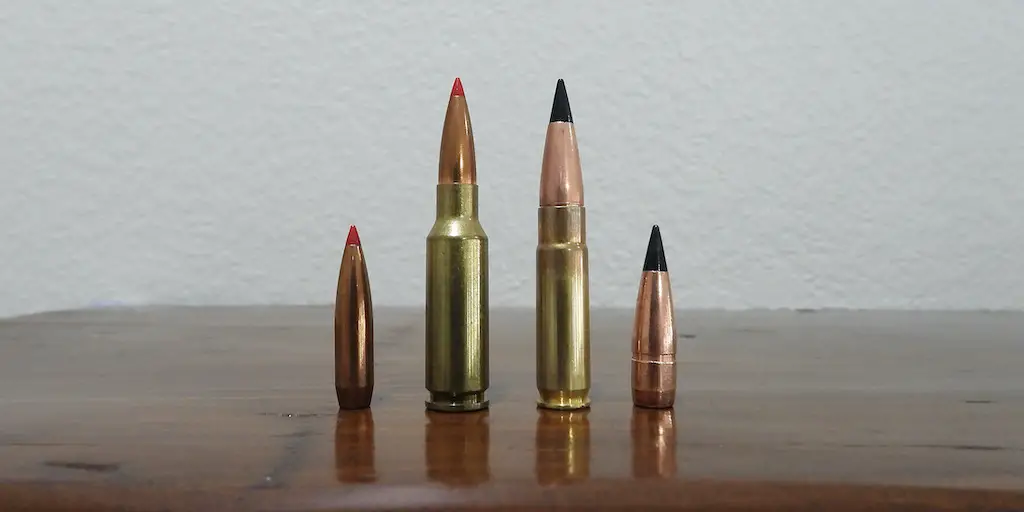
Both cartridges are designed for use in an AR-15, which can only accommodate cartridges up to 2.26″ long. So, the 300 Blackout and 6.5 Grendel each have the same overall length of 2.26″, which is the maximum size cartridge that will fit in an AR-15.
However, the two cartridges have very different dimensions.
The 6.5 Grendel uses a longer case that’s also larger in diameter. The end result is the 6.5 Grendel has a significantly larger case capacity that can hold more powder.
That said, don’t forget the 6.5 Grendel is descended from the 220 PPC and 7.62x39mm cartridges. For this reason, the cartridge has a larger .438″ rim diameter and has more taper than the 223/5.56 cartridge (and the 300 Blackout).
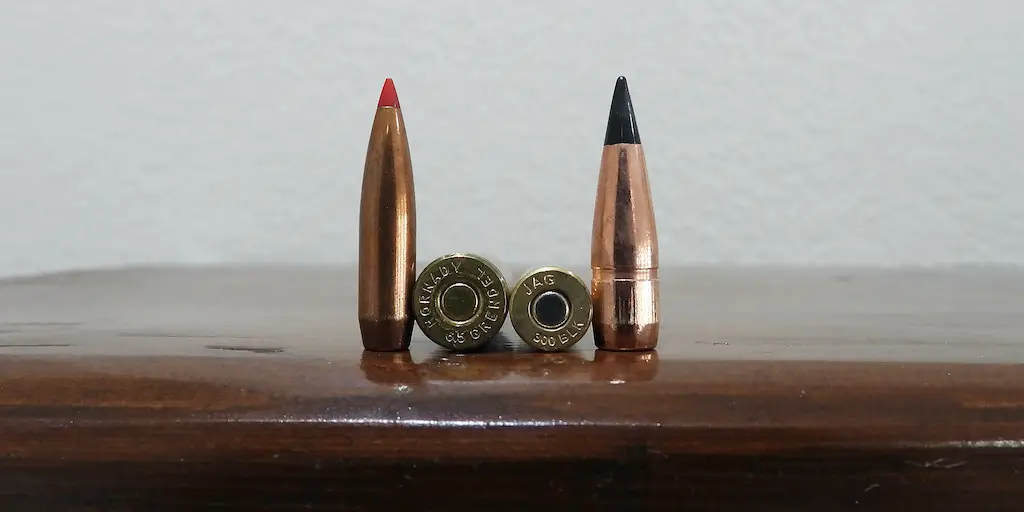
For this reason, the 6.5 Grendel requires a different bolt and (ideally) a special magazine for optimum reliably.
That’s not the case with the 300 AAC Blackout. Since it has the same .378″ rim diameter and an overall shape similar enough to the 223/5.56 cartridge, it can use the same bolt face and magazine as the 223/5.56 cartridges.
We’ll talk more about magazines later in this article.
Finally, the 300 Blackout is loaded to a higher SAAMI maximum average pressure of 55,000psi vs 52,000psi for the 6.5 Grendel.
Note: while the powder capacity figures listed below do give a good indication of the differences between the two cartridges, exact case capacities vary slightly according to the brand of brass used.
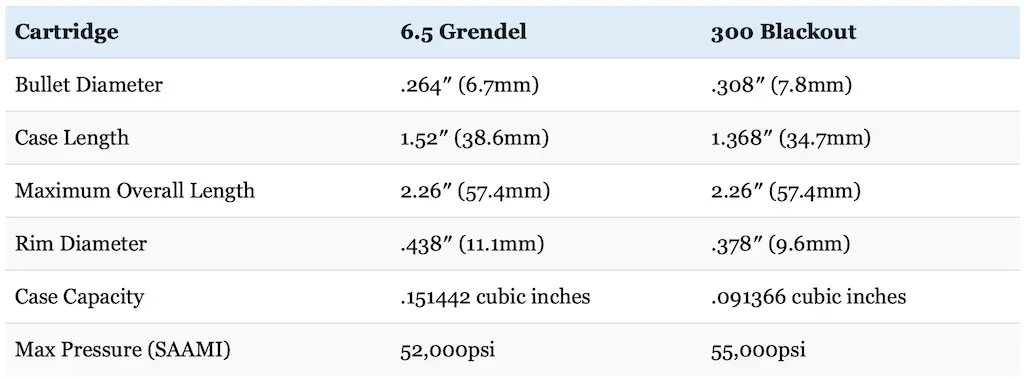
6.5 Grendel vs 300 Blackout Ballistics
The differences in the external dimensions of these cartridges also translates into some interesting differences in their ballistic performance. This is illustrated in the table below comparing Barnes VOR-TX, Hornady Custom, Federal Fusion MSR, and Nosler Ballistic Tip factory ammunition.
The 6.5 Grendel loads use 115gr TTSX (.400 BC), 120gr Fusion (.340 BC), 120gr Ballistic Tip (.458 BC), and 123gr SST (.510 BC) bullets.
The 300 Blackout loads use 110gr TAC-TX (.300 BC), 125gr Ballistic Tip (.366 BC), and 150gr Fusion (.330 BC) bullets.
Notice the various bullets used in those 6.5 Grendel loads all have a higher BC than those used in the comparable 300 Blackout loads.
The Nosler Ballistic Tip and Fusion MSR loadings are two of the very few factory ammo loads that use the exact same bullet for each cartridge. The Barnes loads do not use identical bullets, but I included them below because they’re still pretty similar.
At the same time, I could not do a comparison involving the 6.5 Grendel without including that Hornady Custom 6.5 Grendel load. I think that’s arguably the best 6.5 Grendel factory hunting load in current production. Hornady unfortunately does not produce a 300 Blackout loading using a similar projectile.
All seven loads used a 200 yard zero.
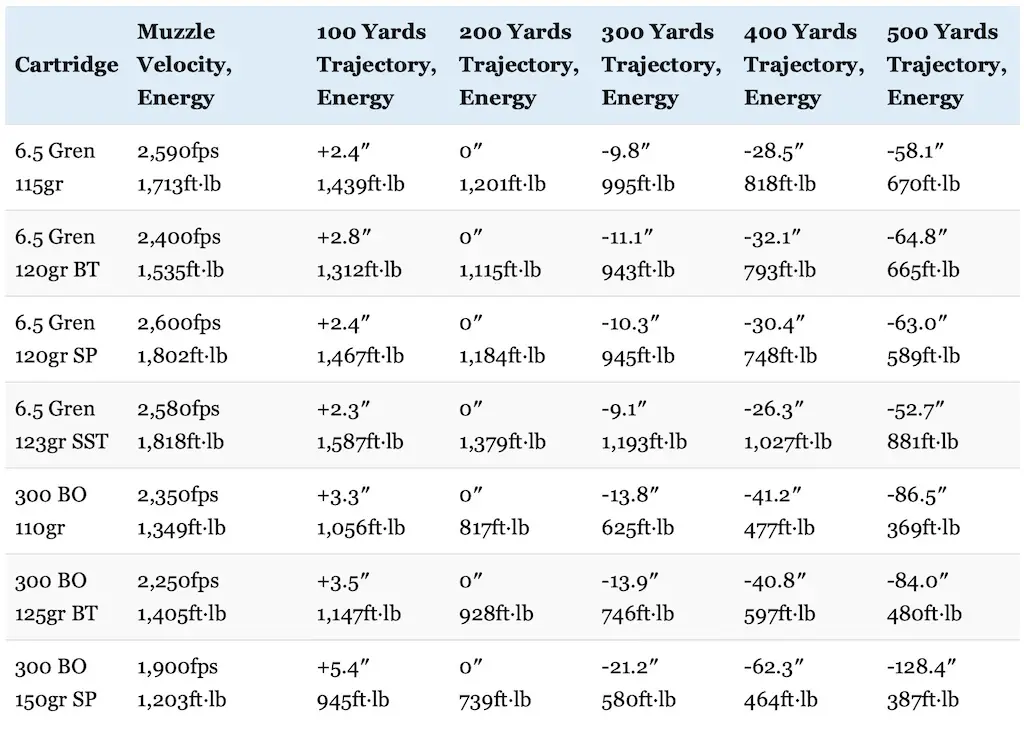
As you can see, the 6.5 Grendel has a significant edge in terms of kinetic energy and trajectory over the 300 Blackout. This is because, due to the advantage the cartridge has in case capacity, the 6.5 Grendel typically has a significantly higher muzzle velocity.
This can vary from 50 to 700fps depending on the exact load in question. While the Federal Fusion loads are somewhat of an outlier due to the especially low muzzle velocity of that heavy 150gr 300 Blackout load, the 6.5 Grendel still has a 150fps edge with the Ballistic Tip loads and a 240fps advantage (even when shooting a slightly heavier bullet) with the Barnes loads.
Heck, the 6.5 Grendel Hornady load is still pushing a 123gr bullet 230fps faster than the 300 Blackout is firing a 110gr bullet with that Barnes load.
The fact that the 6.5 Grendel uses more aerodynamic bullets across the board means that advantage grows as range increases.
So, the 6.5 Grendel starts off with significantly more energy at the muzzle (9-51% more depending on the exact load) and this advantage in retained energy grows as the range increases (23-139% more at 500 yards).
At the same time, while I still wouldn’t describe it as an especially flat shooting cartridge, the 6.5 Grendel also has a significantly flatter trajectory (less bullet drop) at all ranges.
The chart below compares how much a 10 mile per hour crosswind impacts those same 300 Blackout and 6.5 Grendel loads out to 500 yards.
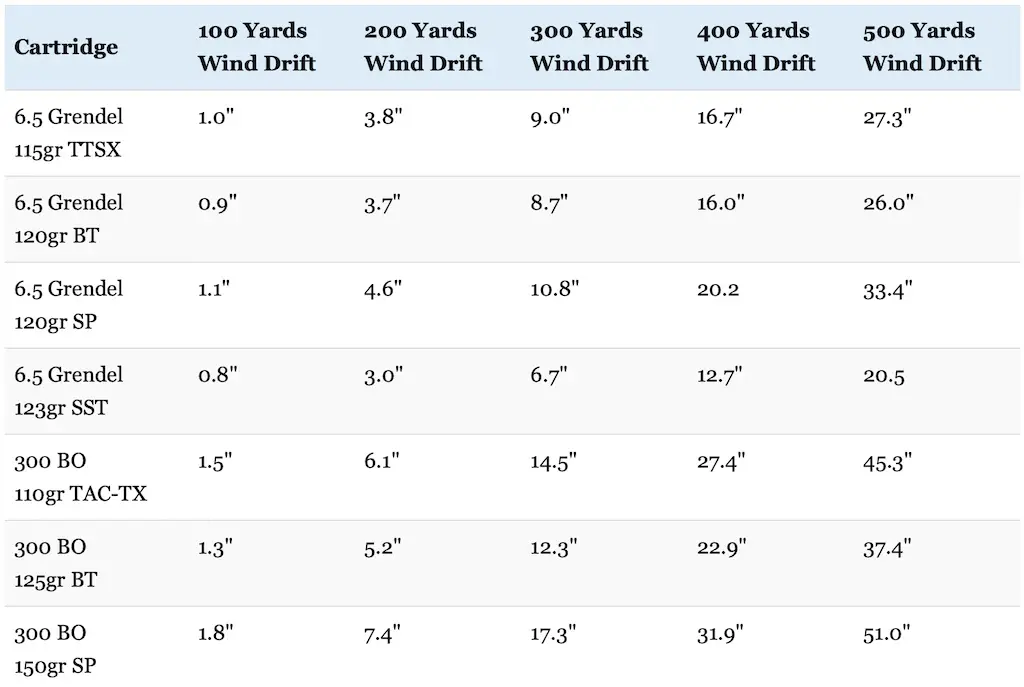
Once again, the 6.5 Grendel handily outperforms the 300 Blackout in terms of wind drift at all ranges. The difference is especially pronounced when comparing that high BC 123gr Hornady load to the 300 Blackout and even the other 6.5 Grendel loads.
Now let’s talk about recoil.
The table below compares the recoil produced by handloads that approximate the performance of the Nosler Ballistic Tip loads when fired from identical 7 pound rifles.
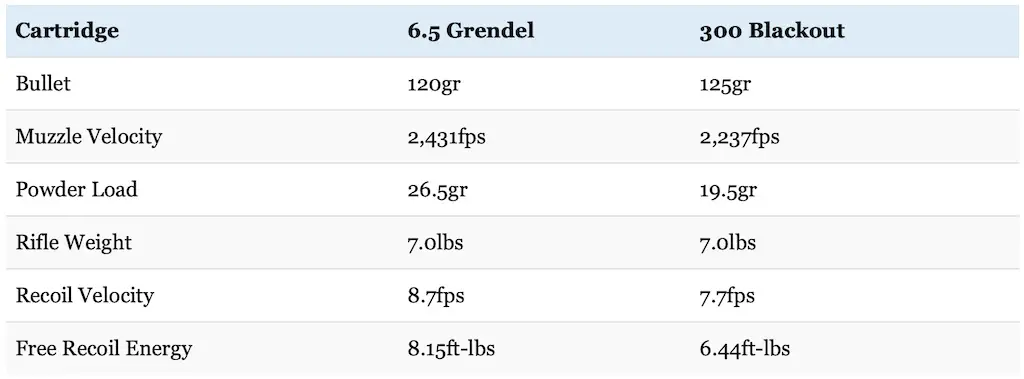
Felt recoil will vary from shooter to shooter and rifle to rifle, but free recoil energy is still a useful way to compare cartridges.
As you can see, the 300 Blackout has about 20% less recoil than the 6.5 Grendel due to the fact that the cartridge uses significantly less powder to push a bullet of similar weight at a slower velocity.
Even so, the 6.5 Grendel is still a relatively mild recoiling cartridge itself. For example, the mild kicking 243 Winchester firing a 100gr bullet at about 3,000fps from a 7 pound rifle produces about 12ft-lbs of recoil.
All things considered, most hunters should be able to handle recoil from both the 300 Blackout and the 6.5 Grendel without too much trouble, though the 300 Blackout has a small edge in this respect, especially for smaller or recoil shy hunters.
Don’t underestimate the impact that recoil has on the ability of a person to shoot accurately either. Some people do handle recoil better than others, but all other things being equal, they will absolutely shoot more accurately with a milder recoiling cartridge.
What about 6.5 Grendel vs 300 Blackout accuracy?
If we’re being honest, both cartridges are absolutely capable of tack driving accuracy (sub-MOA, sometimes much better) in the right hands.
Though the mild recoil of the 300 AAC Blackou gives that cartridge an advantage at short range (150 yards or less), the 6.5 Grendel has a longer effective range and a big advantage at ranges past 200 yards because those heavier and more aerodynamic bullets retain more energy and are less susceptible to wind drift.
So where do we stand with each cartridge?
Additionally, there are a couple of other factors that are also worth discussing.
First, the 300 Blackout uses larger diameter bullets than the 6.5 Grendel.
Specifically, the larger diameter .308″ bullets used by the .300 Blackout have about 36% more frontal surface area (also known as cross sectional area) than the 6.5 Grendel (.0745 vs .0547 square inches). All other things being equal, a bigger bullet will make a bigger hole, cause more tissue damage, and result in more blood loss.
This is a definite advantage in favor of the .300 Blackout.

At the same time, the 6.5 Grendel has a small edge over the 300 Blackout in bullet sectional density.
Sectional density (SD) is a measure of the ratio of the diameter of a projectile to its mass.
All other things equal, a heavier bullet of a given caliber will be longer and therefore have a higher sectional density and consequently penetrate deeper than projectiles with a lower mass and sectional density.
As an example, 110 grain, 120 grain, 150 grain, 190 grain, and 220 grain .308″ bullets have sectional densities of .166, .181, .226, .286, and .331 respectively.
Compare that to 115 grain, 120 grain, and 123 grain .264″ bullets which have sectional densities of .236, .246, and .252 respectively.
While the heaviest 300 Blackout bullets outclass the common 6.5 Grendel bullet weights in terms of sectional density, those heavier bullets for the 300 Blackout are only commonly used in subsonic loadings. The 6.5 Grendel has the edge with the most common bullet weights for each cartridge in supersonic loads.
So where do we stand with each cartridge?
6.5 Grendel vs 300 Blackout
The 6.5 Grendel fires smaller diameter, often lighter, and usually more aerodynamic bullets at a significantly faster velocity than the 300 Blackout. Therefore, the 6.5 Grendel has a flatter trajectory, more resistance to wind drift, and carries significantly more kinetic energy downrange than the 300 Blackout.
300 Blackout vs 6.5 Grendel Ammo
While the 6.5 Grendel and the 300 AAC Blackout are both reasonably popular cartridges, neither can compare to cartridges like the 223 Remington, the .308 Winchester, or the 6.5 Grendel in terms of sheer volume of ammunition sales.
That said, the 6.5 Grendel and the 300 Blackout are both very popular alternatives to the 223 Remington and the 5.56x45mm NATO cartridges in the AR-15 platform and there are some good factory ammo choices for both cartridges.
The big ammunition manufacturers like Barnes, Federal Premium, Hornady, and Nosler all produce quality 6.5 Grendel and 300 Blackout factory ammunition suitable for hunting.
Specifically, 300 Blackout and 6.5 Grendel ammo is available from Barnes in their VOR-TX line, from Federal with their Fusion MSR and American Eagle lines, from Hornady with their American Gunner, Black, and Custom lines, and from Nosler in their Ballistic Tip and Varmageddon lines.
Hornady also produces 300 Blackout ammunition in their subsonic line, which is probably the best option available for those who want to hunt with a suppressed rifle and with subsonic ammunition.
Nosler also offers the 300 Blackout in their Expansion Tip line and the 6.5 Grendel in their Trophy Grade Long Range line.
Alexander Arms still produces 6.5 Grendel ammo and Wolf also offers a pretty good low priced full metal jacket (FMJ) option for the cartridge.
Winchester produces hunting ammunition for the 300 Blackout (but not the 6.5 Grendel) as part of their Deer Season XP and Power Point lines. They also produce some other 300 Blackout loadings better suited for target shooting and self defense.
Remington produces match and/or target shooting loads for both cartridges, but no 6.5 Grendel or 300 Blackout hunting ammo at this instant.
During normal times, it’s usually not that difficult to find 6.5 Grendel or 300 Blackout ammo and most gun or sporting goods stores will have some in stock. However, while they’re by no means rare, many smaller gun stores will not keep 300 Blackout or 6.5 Grendel ammo in stock.
During the 2020-2023 ammo shortage, the difference between the two cartridges has become pretty scrambled and (at least where I live and shop) 300 Blackout ammo is usually easier to find than ammo for the 6.5 Grendel.
Ammo availability is also usually decent online and the bigger retailers typically have a good selection of quality factory ammo for both cartridges as well.
BUY SOME EXCELLENT 6.5 GRENDEL AMMO HERE
BUY SOME GREAT 300 BLACKOUT AMMO HERE
If you’d like to learn more about some of the various hunting ammunition choices for the 300 Blackout and 6.5 Grendel, read these articles:
Best 6.5 Grendel Ammo For Hunting Deer, Hogs, And Other Big Game
Best 300 Blackout Ammo For Hunting Deer, And Other Big Game
Handloaders will appreciate the fact that reloading components for both cartridges are somewhat widely available and there’s an excellent variety of bullet choices for each cartridge. So, you should not have much trouble working up a good custom load for either one if you like to handload.
The 6.5 Grendel shoots the same .264″ bullet size that’s also used by the 6.5×55 Swede, 6.5 Creedmoor(often misspelled 6.5 Creedmore), .260 Remington, and 6.5 PRC (among others).
The .300 AAC Blackout uses the same .308″ bullet size as the .30-30 Winchester, 308 Winchester, the .30-06 Springfield, the .300 Winchester Magnum, the .300 Ultra Magnum, and the 300 PRC.
300 Blackout vs 6.5 Grendel Rifles
Both cartridges are most commonly chambered in semi-automatic rifles, which probably has a lot to do with the fact that both were originally designed for use in the AR-15 platform.
However, there are a couple of good bolt-action rifles chambered in both cartridges.
Alexander Arms manufactured the first rifles in 6.5 Grendel and continues to do so. Since then, Wilson Combat and a couple of other companies like Bear Creek Arsenal, Diamondback, DPMS, Sons of Liberty Gun Works, and Tennessee Arms Company have started producing modern sporting rifles chambered in the cartridge.
The Ruger American Ranch and Predator bolt action rifles are currently manufactured in 6.5 Grendel. The same goes for the CZ 527 and the Howa Mini.
The situation is similar with the 300 Blackout, though there are a few more options in that chambering.
For instance, AR-15 style rifles like those made by Barrett, CMMG, Daniel Defense, Diamondback DPMS, LWRC, Rock River, Ruger, Sig Sauer, and Wilson Combat, are extremely popular with the .300 Blackout.
The .300 Blackout is also available in the Ruger Mini-Fourteen, the Ruger American Ranch rifle, the Mossberg MVP, the CV 527, the Savage 110 and the Remington Model 700 SPS Tactical. It’s even possible to get a .300 AAC Blackout barrel for the single shot Thompson Center Encore.
Of course, it’s also possible to purchase a 6.5 Grendel or 300 Blackout upper receiver and convert an existing AR-15 in a different chambering to shoot the Grendel or Blackout cartridge.
BUY A GREAT 6.5 GRENDEL RIFLE HERE
BUY AN EXCELLENT 300 BLACKOUT RIFLE HERE
300 Blackout vs 6.5 Grendel Magazines
We can’t have a 6.5 Grendel vs 300 Blackout comparison without discussing the magazine situation for each cartridge.
First, since it’s more closely related to the 223 Remington cartridge and has a similar enough overall shape, the 300 Blackout can use regular AR-15/M-16 rifle/M-4 carbine magazines designed for use with the 223/5.56 cartridge without modifications.
Those magazines also still retain a 30 round capacity.
You can purchase 300 Blackout magazines if you want the absolute best reliability, but regular 223 or 5.56 NATO magazines will often work just fine with the 300 Blackout though.
So, keep that in mind if you already have a pile of Magpul mags for your AR-15.
There is one vitally important safety consideration to keep in mind for those who own rifles chambered in both 223/5.56 and 300 Blackout though: a 300 Blackout cartridge CAN indeed chamber and fire with catastrophic results in a 223 Remington or 5.56 NATO chamber.
Trying to push a 30 caliber bullet down a 22 caliber bore will likely destroy your rifle and potentially cause severe injury or death as a result.
Those who own rifles chambered in both cartridges should exercise particular care to avoid mixing ammunition for the two cartridges.
For this reason alone, I think it’s a good idea to purchase dedicated 300 Blackout magazines to further reduce the odds of a serious accident occurring due to mixing ammunition.
Magpul and Lancer (among other companies) produce high quality 300 Blackout magazines with good reputations (both are available below).
BUY SOME EXCELLENT 300 BLACKOUT MAGAZINES HERE
Things are a little different for the 6.5 Grendel though.
That cartridge can use regular M16 rifle/M4 carbine magazines with a slight decrease in magazine capacity (and sometimes in reliability). A typical 30 round 223/5.56 magazine will hold up to 26 6.5 Grendel rounds.
However, the cartridge has a larger rim diameter and significantly different shape compared to the 223/5.56 cartridges. For this reason, purpose built 6.5 Grendel magazines with a modified follower and feed lips provide optimal reliability.
Duramag and ASC produce quality 6.5 Grendel magazines with excellent reputations (both are available below).
BUY SOME GREAT 6.5 GRENDEL MAGAZINES HERE
6.5 Grendel vs 300 Blackout: Which Is Right For You?
Do you primarily hunt medium sized game like whitetail deer or feral hogs at ranges within 200 yards? Both cartridges will absolutely get the job done if you do your part at shorter range. However, I think the 6.5 Grendel has a definite edge here, especially at ranges past 100 yards.
The 6.5 Grendel has more kinetic energy at all ranges, but most 6.5 Grendel hunting loads carry 1,000 ft-lbs of energy out to 200-300 yards. The 123gr SST load is an exception and carries over 1,000 ft-lbs of energy out past 400 yards.
On the other hand, most supersonic 300 Blackout loads only carry 1,000 ft-lbs of energy out to 100 yards. With that in mind, I’d strongly recommend a 100-150 yard maximum for the 300 Blackout on deer sized game.
Are you looking for the better cartridge for long range hunting for game like mule deer or pronghorn in open country where you might need to take a shot at several hundred yards? To be perfectly honest, I don’t like either cartridge for hunting at longer ranges. That said, I think the 6.5 Grendel is a better option than the 300 Blackout in this application since it has a flatter trajectory, quite a little bit less in wind deflection, and carries significantly more energy out past 200 yards.
Do you want a hunting cartridge that’s ideal for black bear, caribou, moose, elk, eland, kudu, or red stag hunting? I consider both too light for this sort of hunting and strongly recommend against using either one on game bigger than deer or hogs.
Do you want the ideal cartridge to use with a suppressor? Both will work in this area, but I think the .300 Blackout is a better choice than the 6.5 Grendel here since this is what the 300 Blackout was specifically designed to do.
Just extreme caution when hunting with .300 Blackout subsonic rounds. Those loads can be very accurate, but there are a lot of bad stories about poor terminal performance on deer and feral hogs when using subsonic .300 BLK ammo.
Hornady makes a 190 grain subsonic load designed specifically for hunting they claim will work very well on big game. I don’t like subsonic ammo for hunting in general, but this is what I’d recommend for someone who insisted on using it.
Are you looking for the perfect cartridge to use in a short barreled rifle (SBR)? Both will lose a certain amount of velocity with shorter barrel lengths, but once again, go with the 300 Blackout here. It performs closer to its full potential with a shorter 16 inch barrel (as well as with a barrel length shorter than 16″ ) and loses less velocity than the 6.5 Grendel in shorter barrels.
The 6.5 Grendel just needs a longer barrel for optimum performance. As a rule of thumb, 18″ is a good minimum barrel length for the 6.5 Grendel. 20″ seems to be the optimum barrel length for the 6.5 Grendel though and even longer barrels aren’t that uncommon.
Do you want a cartridge suitable for self-defense? Both will certainly work in this regard, but there are more choices of purpose built self-defense ammo for the .300 Blackout (like the Barnes TAC-TX, Lehigh Defense Close Quarters Bullet, and others) than the 6.5 Grendel.
Are you looking for an ideal cartridge to use for hunting in an AR-15 platform in general? Both will work and both are improvements over the 223 Remington, but I think the 6.5 Grendel is the most capable and most flexible cartridge that will function in the AR-15.
Are you very sensitive to recoil? Both have very mild recoil, but the .300 Blackout has less than the 6.5 Grendel.
The 6.5 Grendel and the 300 AAC Blackout are both solid rifle cartridges that largely live up to the expecations of those who designed them. However, while there’s some overlap in their performance and ideal uses, they’re not identical. In some areas, the differences between them (6.5 Grendel vs 300 Blackout) are pretty big in many respects.
Carefully evaluate your needs as a hunter based upon the circumstances you foresee using the cartridge in, get a good hunting rifle chambered in the cartridge you select, learn to shoot it well, use quality bullets, and it should serve you well afield.
NEXT: BEST 6.5 CREEDMOOR AMMO FOR HUNTING ELK, DEER, & OTHER BIG GAME
NEXT: BEST GIFTS FOR HUNTERS
NEXT: BEST HUNTING EAR PROTECTION FOR SPORTSMEN
Enjoy this article comparing the 6.5 Grendel and 300 Blackout cartridges? Please share it with your friends on Facebook and Twitter.
The Lyman 50th Edition (p181-182 and p231-233) and Hornady 10th Edition (p301-304 and p435-443) reloading manuals were used as references for the history of the 6.5 Grendel vs 300 Blackout cartridges. I obtained the data used to compare the trajectory of the cartridges from Barnes, Hornady, Federal (here and here), and Nosler (here and here). Data used to calculate recoil was obtained from the Nosler 9th Edition reloading manual (p264 & p463). Case capacity information for the 300 Blackout and 6.5 Grendel were obtained from Backfire TV. Maximum pressure and data to compare cartridge sizes for the 6.5 Grendel and 300 Blackout were obtained from SAAMI (p23 & 29). I used ShootersCalculator.com to compare trajectory and recoil for the cartridges.
Make sure you subscribe to The Big Game Hunting Podcast and follow The Big Game Hunting Blog on Facebook, Instagram, Twitter, and YouTube.
John McAdams is a proficient blogger, experienced shooter, and long time hunter who has pursued big game in 8 different countries on 3 separate continents. John graduated from the United States Military Academy at West Point and is a veteran of combat tours with the US Army in Iraq & Afghanistan. In addition to founding and writing for The Big Game Hunting Blog, John has written for outdoor publications like Bear Hunting Magazine, The Texas State Rifle Association newsletter, Texas Wildlife Magazine, & Wide Open Spaces. Learn more about John here, read some of John’s most popular articles, and be sure to subscribe to his show: the Big Game Hunting Podcast.

